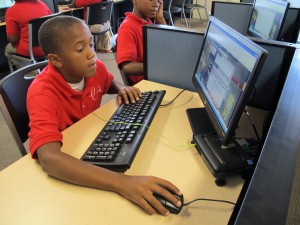How A Federal Prize May Push More Schools To 'Blend' Computer & Classroom

Kyle Stokes / StateImpact Indiana
A student at Carpe Diem charter school logs into a computer in the school's "learning center," where each student has his or her own workstation. It's part of the schools model of "blended learning."
“There’s no way one teacher can adjust every lesson, every concept for thirty different students with different learning styles,” Rick Ogston told StateImpact last week.
But, Ogston says, “the computer, the digital curriculum, can.”
Last week, we profiled the “blended” school Ogston opened in Indianapolis, where students receive a mix of online lessons and in-classroom instruction.
That notion also happens to be the same idea behind another story we’ve been covering — the nationwide Race To The Top competition, where two dozen Indiana school districts have joined nearly 900 school districts in vying for part of a $400 million prize.
The Race To The Top competition “is the first time such a significant tranche of federal dollars will be used expressly to fund blended learning,” Michael Horn writes for Forbes.
Horn’s employer may have a goofy portmanteau for a name — The Innosight Institute — but he’s been blogging very thoughtfully about blended learning and its potential to change education for the better, along with the pitfalls of implementing it on a broad scale:
Past federal initiatives have, in essence, cast technology as tools to be integrated into traditional classrooms—e-textbooks, broadband, and one-to-one laptops, for example. The emphasis has been on the tools rather than the learning.
Although I have some doubts about the wisdom of the Race to the Top competition, and there are other steps that I think the federal government could take that would support a more systematic transformation of our education system, this Race to the Top competition does have the potential to reset American schools’ relationship with technology by encouraging a transformation from a one-size-fits all schooling model to one that can customize affordably for each student’s unique learning needs. The Department’s recent revisions to the competition’s rules were also smart and increase the chances of the competition’s success.
Whether the competition ultimately delivers the goods though depends on the follow through. Done poorly, it could set the movement back ten years by propping up models that perpetuate and sustain the status quo rather than reimagining it, which would have significant negative ramifications. Done well, the competition could be just the national motivation the digital-learning movement has needed to see large-scale adoption of high-quality blended-learning programs.
But there are still limitations to blended learning’s growth. Ogston says he doesn’t feel as though presently-available online learning programs are not as responsive or interactive as they could be — the money simply isn’t there to build better systems, he says.
Critics of blended learning are not convinced the model can be “scaled-up” and introduced to larger numbers of schools.
Krista Glazewski, an IU professor we interviewed for our story last week, points out blended learning has been introduced in small charter schools that don’t necessarily serve the broad populations of students public education must serve.
“It’s not appropriate to hold up a model of blended learning, suggest that this is the next big thing, but also not take that to scale and not show that it can serve a wide range of learners, and that it can serve all sets of diverse learners that exist in public education today,” Glazewksi says.
Your thoughts? Is blended learning “the next big thing”?
